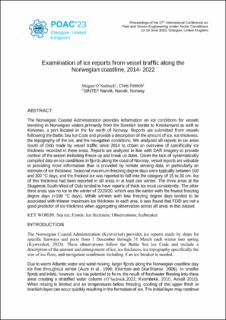| dc.contributor.author | O'Sadnick, Megan | |
| dc.contributor.author | Petrich, Chris | |
| dc.date.accessioned | 2024-03-19T09:32:28Z | |
| dc.date.available | 2024-03-19T09:32:28Z | |
| dc.date.created | 2024-03-14T13:21:54Z | |
| dc.date.issued | 2023 | |
| dc.identifier.citation | Proceedings - International Conference on Port and Ocean Engineering under Arctic Conditions. 2023, . | |
| dc.identifier.issn | 0376-6756 | |
| dc.identifier.uri | https://hdl.handle.net/11250/3123035 | |
| dc.description.abstract | The Norwegian Coastal Administration provides information on ice conditions for vessels traveling in Norwegian waters primarily from the Swedish border to Kristiansand as well as Kirkenes, a port located in the far north of Norway. Reports are submitted from vessels following the Baltic Sea Ice Code and provide a description of the amount of ice, ice thickness, the topography of the ice, and the navigation conditions. We analyzed all reports in six areas South of Oslo made by vessel traffic since 2014 to obtain an overview of specifically ice thickness recorded in these areas. Reports are analyzed in line with SAR imagery to provide context of the season including freeze up and break up dates. Given the lack of systematically compiled data on ice conditions in fjords along the coast of Norway, vessel reports are valuable in providing more information than is provided by remote sensing data, in particularly an estimate of ice thickness. Seasonal maximum freezing degree days were typically between 100 and 300 °C days, and the thickest ice was reported to fall into the category of 15 to 30 cm. Ice of this thickness had been reported in all areas in at least one winter. The three areas at the Skagerrak South-West of Oslo tended to have reports of thick ice most consistently. The other three areas saw no ice in the winter of 2019/20, which was the winter with the fewest freezing degree days (<100 °C days). While winters with low freezing degree days tended to be associated with thinner maximum ice thickness in each area, it was found that FDD are not a good predictor of ice thickness when aggregating observation across all areas in this dataset. | |
| dc.description.abstract | Examination of ice reports from vessel traffic along the Norwegian coastline, 2014-2022 | |
| dc.language.iso | eng | |
| dc.subject | Icebreaker | |
| dc.subject | Icebreaker | |
| dc.subject | Fjords | |
| dc.subject | Fjords | |
| dc.subject | Ice thickness | |
| dc.subject | Ice thickness | |
| dc.subject | Sea ice | |
| dc.subject | Sea ice | |
| dc.title | Examination of ice reports from vessel traffic along the Norwegian coastline, 2014-2022 | |
| dc.title.alternative | Examination of ice reports from vessel traffic along the Norwegian coastline, 2014-2022 | |
| dc.type | Peer reviewed | |
| dc.type | Journal article | |
| dc.description.version | publishedVersion | |
| dc.subject.nsi | VDP::Annen marin teknologi: 589 | |
| dc.subject.nsi | VDP::Other marine technology: 589 | |
| dc.source.pagenumber | 10 | |
| dc.source.journal | Proceedings - International Conference on Port and Ocean Engineering under Arctic Conditions | |
| dc.identifier.cristin | 2254436 | |
| dc.relation.project | Norges forskningsråd: 237906 | |
| cristin.ispublished | true | |
| cristin.fulltext | original | |
| cristin.qualitycode | 1 | |
